If you’re looking to invest globally but dread constant worry about currency swings or complicated tax paperwork, you’re not alone. Many investors want the promise of international diversification, but the reality of managing money across borders can bring headaches few of us are prepared for. The good news: There are practical ways to achieve meaningful global exposure while keeping things simple, both in terms of currency and paper trails. I’ll break down five approaches you might not have considered, weaving in some surprising insights from decades of investing literature and recent innovations.
Think about this: “The four most dangerous words in investing are, ‘this time it’s different.’” —Sir John Templeton. But when it comes to international diversification, in some ways, it really is different today. The dollar’s recent strength, more sophisticated investment products, and shifting global economic power have created both challenges and fresh opportunities. So how can you sidestep the currency confusion and still benefit?
First, let’s talk about multinational corporations. These companies—think Nestlé, Microsoft, or Toyota—earn a sizeable chunk of their profits from outside their home countries. When you buy a share of a major multinational listed in your familiar local market, you’re actually holding a basket of global earnings. For example, Nestlé’s annual reports reveal that only a sliver of its revenue comes from Switzerland; the rest is spread across dozens of currencies and continents. By choosing these giants, I get global exposure, but dividends, taxes, and reporting all still flow through my home brokerage. It’s an indirect approach, but often underappreciated. Have you checked how much of your portfolio already has “invisible” global reach through companies operating in Asia, Europe, or Africa?
Second, global index funds with built-in currency hedging have changed the game. Traditionally, buying a European or Asian index fund meant taking on the risk that euros or yen would weaken just as foreign stocks rallied. But now, many fund providers offer “hedged” versions. These funds use financial tools to protect your investment from currency moves, aiming to deliver returns as if you’d bought the stocks in your own currency. The iShares Currency Hedged MSCI EAFE ETF (HEFA) is a common example—perfect for those who want developed-market diversification without fretting over the dollar-yen or dollar-euro roller coaster. But remember, currency hedging isn’t free—it can eat into returns when your home currency loses value, or if volatility spikes. It’s always worth asking: What do I value more today, stability or potential upside from currency shifts?
American Depository Receipts (ADRs) are a classic but often overlooked shortcut to international markets, especially for U.S. investors. An ADR is essentially a certificate representing foreign shares, traded on a U.S. exchange, and priced in dollars. Tax reporting is standardized, and most brokers handle them just like domestic stocks. Maybe you want to own shares of a British bank or a Japanese automaker, but the prospect of opening international accounts or tracking dividends in foreign currencies is daunting. Buy the ADR instead and sidestep a lot of paperwork. Famous companies like Nestlé, Unilever, and many others offer ADRs. Have you ever run into a research report for a foreign stock and wondered, “Can I even buy this easily?” ADRs might be the answer you never knew you needed.
Now, if you’re willing to dip your toes into emerging markets but don’t want to get lost in translation, local currency bond ETFs can be helpful—if used with care. Traditionally, buying bonds from, say, Brazil or India meant wire transfers, local brokers, and piles of tax forms. Today, U.S.-listed ETFs like EBND package a broad mix of government bonds denominated in local currencies. You get exposure to higher yields and unique macro trends, but with the ease of buying an ETF. Because these funds are traded on domestic exchanges, you don’t have to set up a foreign brokerage or worry about cross-border tax forms. The flipside is that you are taking on currency risk, but it’s contained within a diversified basket. Here’s a question worth considering: What portion of your portfolio thrives when the U.S. dollar weakens, and are you prepared to benefit if that day comes?
Sector-specific international ETFs offer a targeted way to bet on global trends without managing a hodgepodge of international stocks yourself. If you’re convinced Indian technology or global infrastructure is set to surge, why not invest in a fund dedicated solely to that theme? The iShares MSCI India ETF (INDA) or a global infrastructure ETF like IGF gives you access to growth sectors, often hedged for currency risk, with one simple investment. You bypass the complexity of owning dozens of local shares, and you benefit from the research and rebalancing done by professionals. Thematic investing can be especially powerful in markets undergoing structural change—think renewable energy, semiconductors, or healthcare innovation.
Let’s pause for a moment: “Risk comes from not knowing what you’re doing.” —Warren Buffett. It’s tempting to chase hot markets or seek out the next big thing abroad, but if you don’t understand the currency risk, tax implications, or liquidity quirks, you may be building a house of cards. That’s why I always recommend keeping unhedged foreign exposure to no more than 15% of your international allocation. It’s a simple rule that limits surprises when currency markets get wild. Think of it as insurance for your global plans.
This brings me to another underappreciated trick: Pairing volatile emerging market bond funds with steady dividend-paying stocks. The income from mature markets can soften the ups and downs of riskier assets, and help smooth returns when emerging economies hit turbulence. Quarter by quarter, I rebalance, peeling off gains from one bucket to top up the other. Not only does this manage currency drift, but it creates a discipline that’s hard to overstate. In a world where markets are rarely in sync, systematic rebalancing is like setting your sails—the wind may change, but you’re always making progress toward your goals.
There’s also a psychological angle. Investing across borders can feel intimidating, especially when headlines trumpet political crises or currency collapses. But remember that many of history’s best-performing investors have succeeded by venturing where others feared to tread. “The best time to plant a tree was 20 years ago. The second best time is now.” This old proverb rings true in markets as much as in gardening. Don’t let fear of complexity deter you from global opportunities.
Don’t overlook sectors with structural growth tailwinds. Sectors such as global infrastructure, alternative energy, or health technology are often less sensitive to local economic cycles or currency shifts. Funds focused on international infrastructure, for example, benefit from worldwide government spending regardless of whether the dollar is strong or weak. By targeting these areas of durable demand, I can build a portfolio less dependent on macro forecasts or currency guesses.
It’s worth pointing out that while the strategies I’ve discussed each have their merits, the real magic happens when you blend two or three of them together. For example, pairing ADRs with a currency-hedged ETF, or mixing multinational stocks with an emerging market bond fund, spreads risk further and taps multiple drivers of return. Have you experimented with combining different types of international exposure, or do you stick to one method? Sometimes, the best global portfolios are patchworks, not single-thread tapestries.
We all know that tax headaches can cripple enthusiasm for international diversification. Here’s another little-known benefit of ADRs: they often simplify foreign tax credit claims, making it easier to avoid double taxation on dividends. Some custodians even reclaim foreign withholding taxes on your behalf. It’s a small detail, but over a decade, it adds up.
All along, I keep one mantra in mind: simplicity is power. The world of global investing is more open and accessible than ever, but that doesn’t mean you need to chase complexity for its own sake. With a little research, the right mix of products, and a strategy for managing currency drift, you can build an international portfolio that works quietly in the background, compounding for years to come.
Let’s end with this final thought: “In investing, what is comfortable is rarely profitable.” —Robert Arnott. Stepping beyond domestic markets—or even just dipping a toe into foreign sectors—can feel uncomfortable, especially with currency moves always lurking. But with practical tools, a measured approach, and a focus on sectors and companies you understand, international diversification need not be a maze. Instead, it becomes a toolkit for building resilience, finding growth, and making your money work all over the globe, while letting you sleep soundly—free from the tyranny of exchange rates. So, are you ready to broaden your horizons, with a little less worry about currency woes?






